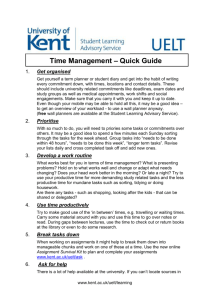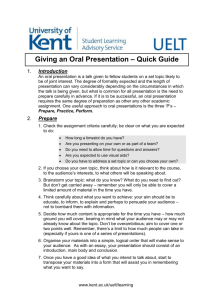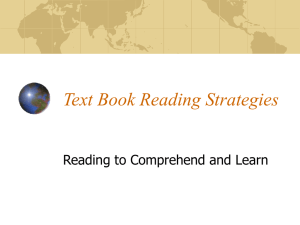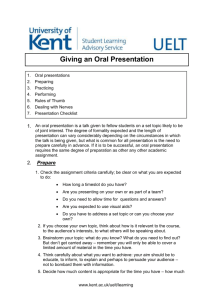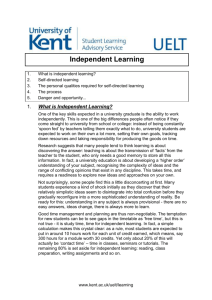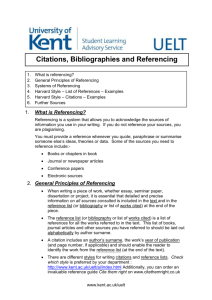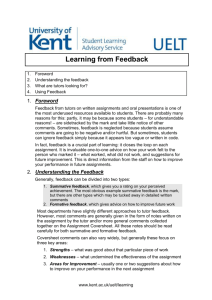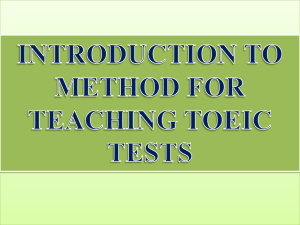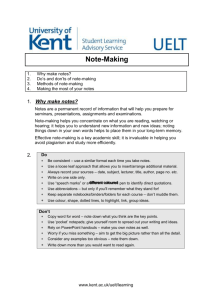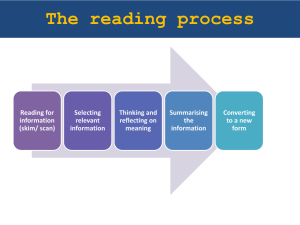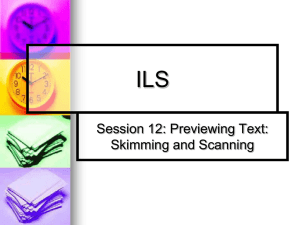Effective reading - University of Kent
advertisement
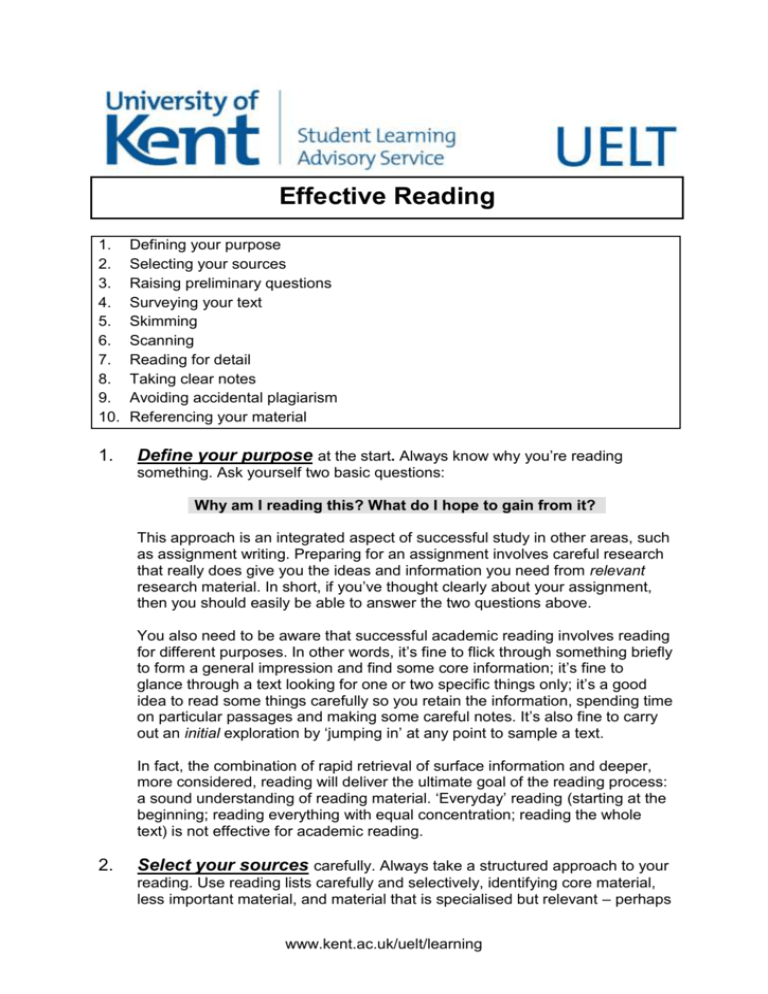
Effective Reading 1. 2. 3. 4. 5. 6. 7. 8. 9. 10. 1. Defining your purpose Selecting your sources Raising preliminary questions Surveying your text Skimming Scanning Reading for detail Taking clear notes Avoiding accidental plagiarism Referencing your material Define your purpose at the start. Always know why you’re reading something. Ask yourself two basic questions: Why am I reading this? What do I hope to gain from it? This approach is an integrated aspect of successful study in other areas, such as assignment writing. Preparing for an assignment involves careful research that really does give you the ideas and information you need from relevant research material. In short, if you’ve thought clearly about your assignment, then you should easily be able to answer the two questions above. You also need to be aware that successful academic reading involves reading for different purposes. In other words, it’s fine to flick through something briefly to form a general impression and find some core information; it’s fine to glance through a text looking for one or two specific things only; it’s a good idea to read some things carefully so you retain the information, spending time on particular passages and making some careful notes. It’s also fine to carry out an initial exploration by ‘jumping in’ at any point to sample a text. In fact, the combination of rapid retrieval of surface information and deeper, more considered, reading will deliver the ultimate goal of the reading process: a sound understanding of reading material. ‘Everyday’ reading (starting at the beginning; reading everything with equal concentration; reading the whole text) is not effective for academic reading. 2. Select your sources carefully. Always take a structured approach to your reading. Use reading lists carefully and selectively, identifying core material, less important material, and material that is specialised but relevant – perhaps www.kent.ac.uk/uelt/learning short journal articles on relatively narrow topics. You should aim to start with core reading to build up your confidence and knowledge. Once you have a good grasp of the subject, move on to more specialised material. In other words, take a strategic approach to your reading selection: Proportion of reading material used in preparing for an academic task Reading sequence Type of material Initial reading Core texts e.g. text books for university study; essential reading identified on reading lists. Probably book-based material, but may well include some journal articles. 40►50% Important reading, probably a mixture of books and journal articles. 20 ►30% Specialised but relevant. Probably journal articles, both hard copy and electronic, and individual WWW sources. 20 ►30% ▼ Secondary reading ▼ Further reading One mistake that many students make is to feel that they must stick to ‘official’ reading at all times, and that there is something wrong in consulting easier texts or sources. As a starting point (but a starting point only), there’s nothing wrong with using, for example, Wikipedia. A straightforward account of a concept or theory may allow you to build on a basic understanding, so more advanced reading proceeds effectively. But please note you should never use a source like Wikipedia as a formal reference! Try and break your reading into manageable ‘chunks’ of texts. If chapters in a book are quite long, break them down into shorter sections. You might want to survey (see below) much longer sections of a text, but when it comes to careful reading that embeds material in long-term memory aim to work with c10-15 pages at a time. 3. Raise preliminary questions. Before you carry out any significant period of reading, spend a little time thinking ahead. What particular issues do you expect to find? What are you looking for? Try and be specific. Think about precise issues that, for example, your assignment requires; think about issues that were not really covered in earlier reading, or issues that still remain unclear despite earlier reading. The important thing is to have a definite ‘agenda’ for your reading. This doesn’t prevent you finding other areas of interest, raising new questions or enjoying the challenge of thinking about unexpected issues. On the contrary, adopting a methodical approach of noting preliminary questions in advance is likely to give your reading greater focus and ‘depth’: you’ll read in a more fluent and perceptive manner; you’ll be more responsive to the text in general. www.kent.ac.uk/uelt/learning Noting questions in advance has two advantages. Firstly, it’s a good way of answering the two key questions above: Why do I want to read this? What do I hope to find out? If you really think about the questions you want answered your selection of reading material will be improved. Secondly, your receptivity to information will be enhanced. Anticipating what’s coming up in a text keeps you focused and builds reading speed. 4. Survey your text before you start your reading. Look at the surrounding information. For example, if you need to read one particular chapter of a book, make sure you skim-read (see below for skim reading) the introduction to the book. The introduction will give you an account of the concepts and underlying argument of the whole book and an account of the surrounding chapters. The introduction will probably be fairly succinct; skim reading it shouldn’t take more than 10-15 minutes, but it will ‘set you up’ for your actual reading task. It’s surprising how much you can gain from an overview of a text, but it needs to be as rapid as possible otherwise you’ll get bogged down in what feels like a mass of extra reading. If you get into the habit of surveying, it will become a natural part of the reading process. It works particularly well with book material, but can be adapted to journals and www resources: Books ▼ Journals ▼ WWW resources ▼ Title + series Year of publication Revision/edition Foreword/introduction Contents Index Charts/tables Diagrams Maps Illustrations Chapter headings Early sections of chapters (skim-read) Editorial comments Titles of other papers Abstract (+Abstracts for other papers) Footnotes/citations Charts/tables Opening section + closure/conclusion (skimread) Site map Sources Sponsoring organisation Information about the author Date produced Date revised No. of ‘hits’ (if available) Visual material Links to other sites The net result of a good survey approach is that when you turn to read the exact section/text you need to, you’re already ‘hard-wired’ with a sense of what you’ll find, and will read more effectively, retaining more of what you’ve read. 5. Skim your text before you start reading more carefully, and after the survey stage. Skim reading is a technique where you deliberately try and take in the gist of what you are reading without bothering about the detail. You might think of it as a kind of constructive superficiality! Skim Reading i. Read as quickly and as smoothly as possible, letting your eye travel from left to right and then from top to bottom of a page of text. Use a ruler, a pencil, a folded sheet of paper – or your finger – to ‘pull’ your eyes across and down the page. www.kent.ac.uk/uelt/learning ii. Keep going! Set aside the time (10 minutes, say, for 10 pages) to make sure you skim read the whole text in one go. iii. If you’re blocked on a particular word or phrase that you don’t quite get, disobey your natural instinct to stop and wrestle with the concept. Keep reading forwards all the time and understanding will follow. iv. Think ahead about any particular words or terms that are either new to you, or you don’t quite understand. Anticipate any terms that might be ‘blockers’ in your text by learning them in advance. v. Look for the key sentences in any one paragraph. Often an academic paragraph will be based on a key topic sentence and the evidence that supports it. Try and isolate these from the rest of the paragraph. vi. Some students find that quickly reading the first and last sentence of each paragraph is a good way to skim read a text. vii. If you do feel you really can’t read without taking notes, take the briefest possible notes, or a few very, very brief annotations. Don’t be tempted into making detailed notes that summarise the whole of a passage in sequence. A few bullet-points will be fine! The aim of skim reading is have a general sense of what the text is saying (a kind of sketch-map of the territory, as it were). This general understanding will allow you to absorb particular information more effectively on a subsequent reading. Moreover, when you absorb more information – by reading ahead – you may well be able to make ‘retrospective sense’ of earlier content. So, read lightly, read quickly and keep it going… until you’re ready for the second stage. 6. Scan read a few pages or sections of your text, reading slowly (but still with forward momentum.) As you read at the skim stage, you’ll probably have put brief pencil marks/annotations on a few passages you were ‘blocked’ on. In addition, you may well have noticed some particular passages that related to some of the questions you raised in advance (Section 3 above.) Or there may well have been a few passages that simply caught your interest! In total, restrict your scan reading to specific topics, and less than 20% of the whole text. In scan reading you’re trying to read more carefully, so make sure you identify topic sentences and evidence in each section. Take summative notes as well, but keep them brief and purposeful. Although you’re working in detail with only part of the text, your more careful thinking, coupled with the sense of context gained from earlier skim reading, will allow you to see the whole text more clearly and gain a stronger sense of its overall meaning(s). 7. Now you’re ready to read for detail! The preliminary strategies outlined above, steps 3-6, will now put you in a position where your detailed reading will proceed efficiently and effectively. You will be able to focus on the passage concerned, aware of its underlying meaning and purpose. Of course, your understanding won’t be instantaneous. There’ll be the need to engage with individual sections of your text, extracting the key points and the evidence that supports them. But you have a ‘platform’ on which to build! www.kent.ac.uk/uelt/learning In reading for detail, go to the start of the text – follow the chronology of the text, tracing the development and exploration of its argument. Constructive regression (returning to earlier parts of the text) is fine, as long as its purpose is to focus on the main narrative. But avoid darting about and flicking through other sections (fine at the skim reading stage!) in favour of careful, systematic sequential reading from start to finish. That means picking up page one of a chapter, journal article etc and carrying on from there; or, if it’s a question of reading two or three pages from a text, starting at the first paragraph and going on to the second. 8. Reading alone won’t deliver all that you’re really looking for: to retain the information you need from the text. It’s essential to take clear notes, where the process of selecting, paraphrasing and summarising information from the text really builds understanding. Only when you take the words and meaning of the text and convert it into your own language will you begin to truly understand! This is especially the case where you are seeking to embed some of your reading in an assignment, and need to draw from your reading over a period of time. You will need a series of purposeful notes that allow you to integrate seamlessly your reading material into your assignment. A common mistake that many students make, especially those new to university study, is to start taking notes at their first reading! This is a very difficult, indeed almost impossible, task! The key to good reading and notetaking is context and anticipation – knowing what to expect because you have established a general sense of the material. So all the strategies outlined in sections 3-7 above not only allow you to read more effectively, but allow you to take good notes too. Six Stages of Effective Note-taking i. Always read effectively in advance. ii. Take the text passage by passage, using the sequential approach outlined in section 8 above. iii. Always use your own words, except if there’s a really strong reason for retaining the language of the original. iv. If you really do need to use the original words make sure you separate the words you copy from your source material from your own words. See section 9 below. v. Make sure your notes are selective. Aim to capture the essential points. Don’t make your notes a shortened version of the whole text. See section 3 above. vii. The purpose of taking notes is not just to shrink the original text, but to work creatively with the information in the original, extracting it, re-processing it and re-arranging it so that you really understand it. 9. In taking notes from reading material, it’s also essential to avoid accidental plagiarism. This is often the result of using notes that don’t www.kent.ac.uk/uelt/learning clearly distinguish between the student’s paraphrases and summaries and the words/language of the original. The way to avoid this confusion, and subsequent accusations of plagiarism, is to establish a clear distinction between your own words and phrases and the language of the original. Obvious methods include using speech marks for all quotations, no matter how brief, or a differently coloured script. Another, virtually foolproof, method for avoiding this mistake is to create a proforma template to record your notes from reading which separate entirely any quotations from the source material in such a way that it’s impossible to muddle them up with your own words: 10. Any notes you take from your reading must allow you to reference your material, hence the bibliographical information in the template above and the record of page numbers for text-based sources. This information is essential for avoiding unintentional plagiarism, as it allows you to use a proper referencing technique. Every piece of work you submit for assessment must be fully and correctly referenced, so you must understand fully how to provide in-text citations, and a reference list and/or bibliography. Specific and different methods of referencing are used within different faculties and academic departments – Harvard, MHRA, OSCOLA, APA, MLA, Chicago, Vancouver, etc. So, it’s vital that you know exactly what your module convenor and department require you to do, and follow the guidelines that are available for you. The Student Learning Advisory Service has a link to the Academic Integrity web pages authored by the Curriculum Development Team in UELT; this includes a link to departmental referencing style guides classified by Faculty, alongside a general explanation of plagiarism and academic integrity. Please see http://www.kent.ac.uk/uelt/ai/students/index.html www.kent.ac.uk/uelt/learning
